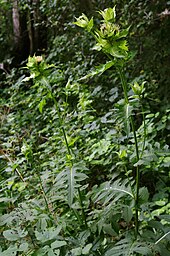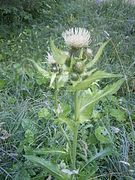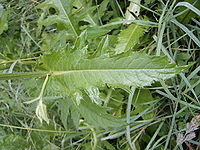Cabbage thistle
| Cabbage thistle | ||||||||||||
|---|---|---|---|---|---|---|---|---|---|---|---|---|

Cabbage thistle ( Cirsium oleraceum ), illustration |
||||||||||||
| Systematics | ||||||||||||
|
||||||||||||
| Scientific name | ||||||||||||
| Cirsium oleraceum | ||||||||||||
| ( L. ) Scop. |
The cabbage thistle ( Cirsium oleraceum ), also simply called cabbage thistle , is a type of plant from the genus of the seared thistle ( Cirsium ) within the sunflower family (Asteraceae).
description
The cabbage thistle is a perennial herbaceous plant that reaches heights of 50 to 170 cm. It is not stinging. Its stem is leafed away to the tip. The leaves are soft, the upper ones mostly undivided, heart-shaped, encompassing stems; the lower lobed pinnate.
Two to six cup-shaped inflorescences are clustered together at the stem ends. The egg-shaped, soft thorny, undivided, yellow-green bracts tower above the flowers. The tubular flowers are pale yellow. The flowering period extends from June to October.
The number of chromosomes is 2n = 34.
ecology
The cabbage thistle is a hemicryptophyte . It sometimes occurs on a massive scale because it is promoted by fertilization and nutrient enrichment resulting from pollution. However, it is not a valuable forage crop, is rather spurned by grazing animals and is also unsuitable for drying because it crumbles easily. It is a deep-rooting and fertilization pointer.
The pollination is effected by insects ( Lepidoptera and bees ). It is a nectar and pollen dispenser of particular value.
The fruits experience a spread as umbrella fliers and watery ones, and processing spread by finches , tits , linnets and crossbills also takes place.
Occurrence
The Cabbage Thistle flourishing of Western Europe to Western Siberia at all altitudes, except for the Alpine altitude level .
The cabbage thistle grows widespread in wet meadows and alluvial forests, in herbaceous vegetation on brook banks and springs. She loves base-rich and moderately nitrogen-rich soil. According to Ellenberg , it is a wet pointer and an association of the character of fertilized wet meadows ( Calthion ). According to Oberdorfer , it is a weak species of the Angelico-Cirsietum oleracei, but also occurs in societies of the associations Calthion, Atropion or Alno-Ulmion or the order Molinietalia.
In the Allgäu Alps, it rises at the Walmendinger Horn in Vorarlberg to an altitude of 1930 meters.
use
In Eastern Europe and Siberia , and occasionally in Central Europe , it is used as a vegetable and is cultivated in Japan for this purpose.
The leaves and the "rhizome" are eaten cooked. The "rhizome" is rich in inulin . Young leaves can also be eaten raw. The dried rhizome can be ground into flour that can be used to thicken food. Similar to artichokes, the cooked flower base can also be eaten.
Common names
For the cabbage thistle the other common German names exist or existed :
| Common name | Language area | local limitation | comment |
|---|---|---|---|
| Soft thistle | Middle High German | ||
| Safflower cabbage | Middle High German | ||
| Horse cabbage | Middle High German | ||
| Meadow thistle | Middle High German | Eifel | |
| Meadow oil | Middle High German | Memmingen | |
| piston | Middle High German | Memmingen | |
| Grass oil | |||
| Terrible weed | Lausitz | ||
| Laevis thistle | Silesia | ||
| Geele thistles | Silesia | ||
| Wild cardo deans | Silesia | ||
| Wild safflower | Carinthia near Glödnitz | ||
| Shareweed | Carinthia near Glödnitz | ||
| Bach Charter | St. Gallen near Sargans | ||
| Schwischarta | St. Gallen near Sargans | ||
| Charter | St. Gallen near Werdenberg | ||
| Suscharta | St. Gallen on the Rhine | ||
| Haircut | Swiss German | Switzerland |
- More pictures
Habit and inflorescence.
literature
- Cabbage thistle. In: FloraWeb.de.
- Ruprecht Düll , Herfried Kutzelnigg : Pocket dictionary of plants in Germany and neighboring countries. The most common Central European species in portrait . 7th, corrected and enlarged edition. Quelle & Meyer, Wiebelsheim 2011, ISBN 978-3-494-01424-1 . (Section ecology)
- Helga Hoffmann: Wild herbs and berries. 1st edition. Gräfe and Unzer Verlag GmbH, Munich 2012, ISBN 978-3-8338-2611-5 .
Individual evidence
- ↑ a b c Erich Oberdorfer : Plant-sociological excursion flora for Germany and neighboring areas . With the collaboration of Angelika Schwabe and Theo Müller. 8th, heavily revised and expanded edition. Eugen Ulmer, Stuttgart (Hohenheim) 2001, ISBN 3-8001-3131-5 , pp. 966 .
- ↑ Erhard Dörr, Wolfgang Lippert : Flora of the Allgäu and its surroundings. Volume 2, IHW, Eching 2004, ISBN 3-930167-61-1 , p. 641.
- ↑ Entry in Plants for a Future . (engl.)
- ↑ H. Hofmann: Wild herbs and berries. , 2012, p. 227.
- ^ Georg August Pritzel , Carl Jessen : The German folk names of plants. New contribution to the German linguistic treasure. Philipp Cohen, Hannover 1882, page 101. ( online ).
- ↑ Horse cabbage at books.google.de, "Bienenweide"
Web links
- Cabbage thistle . In: BiolFlor, the database of biological-ecological characteristics of the flora of Germany.
- Profile and distribution map for Bavaria . In: Botanical Information Hub of Bavaria .
- Cirsium oleraceum (L.) Scop. In: Info Flora , the national data and information center for Swiss flora . Retrieved June 17, 2016.
- Distribution in the northern hemisphere according to Hultén
- Thomas Meyer: Thistle data sheet with identification key and photos at Flora-de: Flora von Deutschland (old name of the website: Flowers in Swabia )
- Characteristics.
- Images: Kohl-Kratzdistel ( Memento from July 16, 2007 in the Internet Archive ), [1] , [2]




